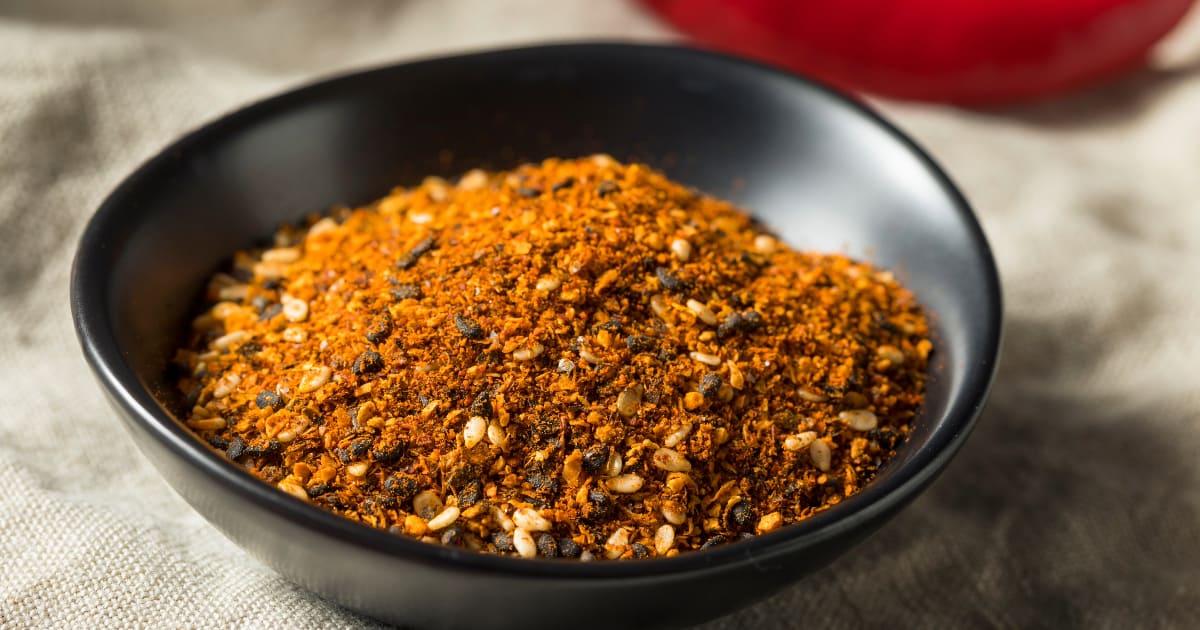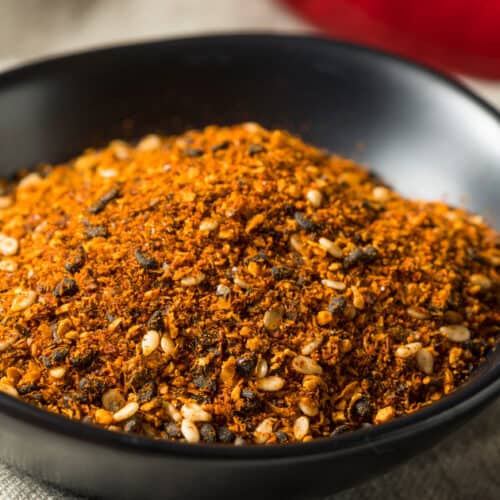Shichimi powder, also known as Japanese 7 spice or shichimi togarashi, is a popular Japanese spice blend that typically contains 7 ingredients - hence the name. It packs a punch of spicy, citrusy, nutty, and umami flavors that can be sprinkled over a variety of savory dishes.

If you love Japanese cuisine or spicy seasonings, learning how to make shichimi powder at home is easy and rewarding. Not only does it allow you to customize the heat level and flavors to suit your tastes, but homemade shichimi powder also tends to be more fragrant and flavorful than store-bought varieties.
Shichimi powder, sometimes spelled shichimi togarashi, first originated in Japan during the Edo period, around the 17th century. The name translates to “seven flavors chili pepper”, as traditional shichimi contains seven ingredients.
certain ingredients or add extras like hemp seeds, orange peel, shiso leaf, or garlic powder. So feel free to customize based on your tastes!
How to Make Shichimi Powder from Scratch

Shichimi Powder Recipe
Ingredients
- 2 tablespoons red chili flakes
- 1 tablespoon dried yuzu peel (or lemon/orange peel)
- 1 tablespoon white sesame seeds
- 1 tablespoon black sesame seeds
- 1 teaspoon nori seaweed flakes
- 1 teaspoon sansho peppercorns (or Sichuan pepper)
- 1 teaspoon ground ginger
- 1/2 teaspoon poppy seeds
Instructions
- Add the white and black sesame seeds to a small skillet over medium heat. Toast for 2-3 minutes while stirring frequently until lightly browned and fragrant. Immediately remove from heat and set aside to cool.
- Using a mortar and pestle or small grinder, coarsely grind the toasted sesame seeds, dried yuzu peel, sansho peppercorns, and nori seaweed flakes one ingredient at a time.
- Transfer to a small bowl. Add the ground ginger, red chili flakes, and poppy seeds. Whisk ingredients together until thoroughly combined.
- Transfer homemade shichimi powder to an airtight container like a jar or spice bottle. Store in a cool, dark place for up to 1 month.
And that's it - you now have flavorful homemade Japanese seven spice blend! Customize it to suit your tastes by playing around with the ingredients and ratios. Sprinkle it onto your favorite Asian or fusion dishes.
Key Takeaway: To make shichimi powder at home, simply toast the sesame seeds, then grind them along with yuzu peel, sansho pepper, nori, ginger, chili flakes, and poppy seeds. Mix together and store in an airtight container.
How to Use Shichimi Powder
In Japan, shichimi togarashi is commonly served alongside noodles like ramen, udon, and soba. It can also be sprinkled over rice, eggs, tempura vegetables, grilled skewered meats and fish, and soups for extra zing.
Beyond Japanese cuisine, this versatile spice blend can amplify flavor in all types of global dishes:
- Toss with roasted veggies or avocado toast
- Use as a dry rub or marinade for meats
- Shake over popcorn, fries, chips or crackers
- Stir into salad dressings, dips, and sauces
- Mix into tempura batter or panko breadcrumbs when frying
- Add to soups, stews, chilis, and curries
- Sprinkle on pizza, pasta, stir fries, burgers and more
Start with just a pinch or two at first. A little shichimi powder goes a long way since it packs quite a punch! Then adjust the amount to suit your heat preferences.
Key Takeaway: In Japan, shichimi powder is commonly served with noodles, rice, eggs and grilled foods. But it can amplify flavor in all types of global dishes too, from veggies to popcorn and more.
5 Delicious Ways to Use Homemade Shichimi Powder
Looking for culinary inspiration on how to enjoy your freshly made shichimi togarashi? Here are 5 tasty ways to put this spice blend to deliciously good use:
1. Shichimi Shrimp Tempura
For an extra kick of heat and flavor, add a teaspoon of shichimi powder to tempura batter when deep frying shrimp or vegetables. It beautifully complements the crispy shell surrounding the tempura. Dip in tentsuyu sauce seasoned with a pinch of shichimi too.
2. Shichimi Tomato Salad
Toss juicy cherry tomatoes with this simple Japanese tomato salad dressing: olive oil, rice vinegar, touch of honey, salt, shichimi powder to taste. The sweet-tart dressing paired with spicy shichimi makes a perfect complement to fresh ripe tomatoes.
3. Shichimi Chicken Skewers
Jazz up chicken skewers by coating bite-size pieces with a sweet miso marinade mixed with a teaspoon or more shichimi powder. Let marinate 30 minutes or overnight. Grill until nicely charred.
4. Shichimi Soba Noodles
For a quick weeknight meal, boil soba noodles according to package directions. Drain and lightly rinse under cold water. Toss noodles with a tablespoon or two of savory tsuyu dipping sauce and desired amount of shichimi powder. Top with chopped scallions.
5. Shichimi Deviled Eggs
Add some heat to classic deviled eggs by mixing a pinch or two of shichimi powder into the egg yolk filling before spoon it back into the cooked egg whites. Garnish deviled eggs with extra shichimi, black sesame seeds, nori flakes or microgreens.
With just a sprinkle of homemade shichimi togarashi, ordinary dishes instantly become extraordinary. This Japanese 7 spice blend infuses food with addictive layers of tangy citrus, nutty sesame, ocean-y umami from nori seaweed, warming ginger and chili heat.
FAQs
Can I adjust the spiciness of homemade shichimi powder?
Yes, absolutely! To make it spicier, use more red chili flakes or a hotter variety like Thai bird's eye chilies. For milder heat, use less chili flakes or a milder kind like Guajillo or Anaheim.
What can I use if I don't have yuzu peel?
Yuzu is a Japanese citrus fruit. If unavailable, you can substitute dried lemon, lime, grapefruit or orange peel instead. Use the same quantity as you would yuzu.
Are there any substitutes for sansho peppercorns?
Sansho brings unique floral, citrusy notes but can be hard to source. Ground Sichuan peppercorns make the best replacement. Or leave it out entirely.
Can I use a regular blender instead of mortar & pestle or grinder?
It's best to grind the spices just until chopped and coarse, not into a fine powder. If your blender can accomplish a very coarse texture, you may use it. Otherwise stick to a mortar and pestle or small manual grinder.
Can I toast the sesame seeds in the oven instead of on the stovetop?
Yes, absolutely! Spread sesame seeds out evenly on a baking sheet. Toast at 325°F for 5-7 minutes, stirring halfway through. Monitor closely to avoid burning.
Conclusion
Now that you know how to make fantastic homemade shichimi togarashi from scratch, you can create customized spice blends to suit your palate. Play around with adjusting the quantities or types of ingredients until you formulate your ideal mixture of spicy heat, nutty sesame, citrusy tang and seaweed umami.
Garnish an selection of favorite Japanese, Asian or fusion dishes with your hand-crafted Japanese seven spice. Or expand beyond Asian cuisine by shaking it over everything from eggs and pizza to roasted veggies and burgers too.
Resources:
- Wikipedia - This page describes Shichimi powder, including its history and ingredients.
- Japan Today - This page explains the health benefits of Shichimi Powder and provides a recipe for making it at home.
- Umami Insider - This page offers a premium blend of Shichimi Powder for purchase, along with suggestions for how to use it in cooking.
- The New York Times - This site provides a recipe for making Shichimi Powder at home, along with suggestions for how to use it in cooking.
- All Ways Delicious - This page offers a recipe for making Shichimi Powder at home, along with suggestions for how to use it in cooking.

